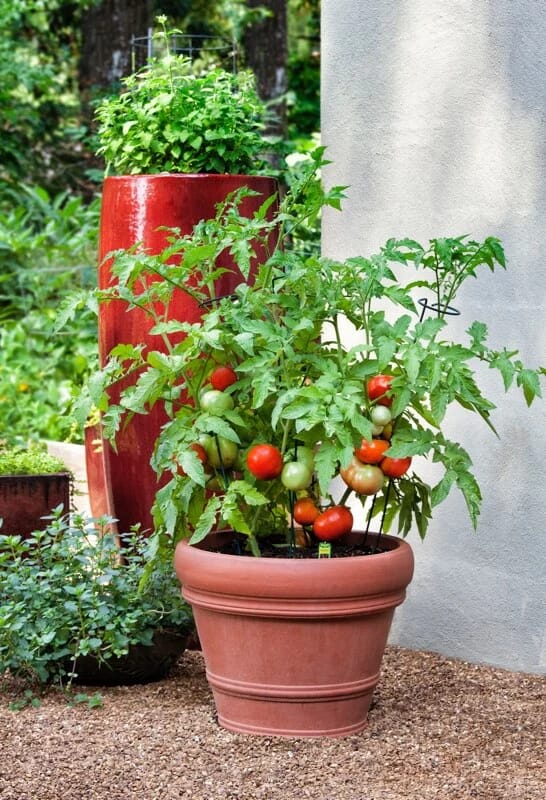How to Successfully Grow Tomatoes at Home

Growing tomatoes at home can be a highly rewarding experience, providing you with fresh, delicious tomatoes right from your garden or balcony. Here’s an extensive guide to help you grow tomatoes successfully.
1. Choose the Right Variety

There are numerous tomato varieties, each with its own growth requirements and fruit characteristics. Selecting the right variety is crucial for a successful harvest. Common types include:
- Determinate: Bush-type tomatoes that grow to a certain height and then stop, producing all their fruit at once. They are ideal for container gardening or small spaces.
- Indeterminate: Vine-type tomatoes that continue to grow and produce fruit throughout the season, making them best suited for larger spaces with adequate support structures.
Consider factors like your local climate, the space you have available, and your personal taste preferences when choosing a variety. Popular varieties include ‘Roma,’ ‘Beefsteak,’ ‘Cherry,’ and ‘Heirloom’ tomatoes.
2. Start with Quality Seeds or Seedlings

You can start tomatoes from seeds or purchase seedlings from a nursery. If starting from seeds, follow these steps:
- Timing: Start seeds indoors 6-8 weeks before the last expected frost date in your area.
- Seedling Care: Use a seed-starting mix and keep the soil moist but not waterlogged. Provide plenty of light, either from a sunny window or grow lights, for about 14-16 hours a day.
- Transplanting: Once seedlings have at least two sets of true leaves and are about 6-10 inches tall, they are ready to be transplanted into the garden or larger containers.
3. Prepare the Soil

Tomatoes thrive in well-draining, nutrient-rich soil. Proper soil preparation is key to healthy plants and a good harvest. Here’s how to prepare your soil:
- Soil pH: Tomatoes prefer slightly acidic to neutral soil, with a pH between 6.0 and 6.8. Test your soil and amend it if necessary.
- Amendments: Improve soil fertility by mixing in plenty of organic matter such as compost or well-rotted manure. This enriches the soil with nutrients and improves its structure.
- Drainage: Ensure the soil has good drainage. If your soil is heavy clay or tends to retain water, consider raised beds or adding sand and organic matter to improve drainage.
4. Planting Tips

Proper planting techniques are crucial for the healthy development of tomato plants:
- Spacing: Plant determinate varieties 18-24 inches apart and indeterminate varieties 24-36 inches apart to allow adequate airflow and reduce the risk of disease.
- Depth: Plant seedlings deep, burying about two-thirds of the stem. This encourages the growth of additional roots along the buried stem, leading to a stronger, more resilient plant.
- Support: Install stakes, cages, or trellises at the time of planting. Supporting your plants helps keep the fruit off the ground, reducing the risk of disease and pest damage.
5. Watering

Consistent watering is essential for healthy tomato plants and preventing issues like blossom end rot:
- Frequency: Water deeply and regularly, keeping the soil consistently moist but not waterlogged. Tomato plants typically need 1-2 inches of water per week, depending on the weather and soil conditions.
- Technique: Water at the base of the plant to avoid wetting the foliage, which can lead to fungal diseases. Drip irrigation or soaker hoses are effective methods for delivering water directly to the roots.
6. Fertilization

Tomatoes are heavy feeders and benefit from regular fertilization to support their growth and fruit production:
- Initial Feeding: Apply a balanced fertilizer at planting time. Look for a fertilizer with equal parts nitrogen (N), phosphorus (P), and potassium (K).
- Ongoing Feeding: Once plants begin to flower and set fruit, switch to a high-phosphorus fertilizer to promote fruit development. Follow the recommended application rates on the fertilizer package to avoid over-fertilization, which can lead to excessive foliage growth at the expense of fruit production.
7. Mulching

Mulch helps retain soil moisture, suppress weeds, and regulate soil temperature, contributing to the overall health of your tomato plants:
- Materials: Use organic mulch such as straw, grass clippings, shredded leaves, or compost. Avoid using fresh grass clippings or materials that can mat down and create a barrier to water and air.
- Application: Apply a 2-3 inch layer of mulch around the base of the plants, keeping it a few inches away from the stems to prevent rot and pest issues.
8. Pruning and Maintenance

Regular pruning and maintenance are essential for promoting healthy growth and maximizing your tomato yield:
- Pruning: Remove suckers (the small shoots that grow in the crotch between the main stem and branches) to direct the plant’s energy towards fruit production. Be careful not to over-prune, as some foliage is necessary to protect the fruit from sunscald and to support photosynthesis.
- Monitoring: Regularly inspect your plants for signs of pests and diseases. Common issues include aphids, tomato hornworms, and fungal diseases like blight. Early detection and intervention are key to managing these problems.
9. Harvesting

Knowing when and how to harvest your tomatoes ensures the best flavor and quality:
- Ripeness: Harvest tomatoes when they are fully colored and slightly firm to the touch. The exact timing will depend on the variety and your personal taste preferences.
- Technique: Use a gentle twisting motion or garden shears to remove the tomatoes from the vine. Avoid pulling or tugging, as this can damage the plant and other fruits.
10. Common Problems and Solutions

Be prepared to address common tomato-growing issues to ensure a healthy and productive garden:
- Blossom End Rot: Often caused by inconsistent watering or calcium deficiency. Ensure even watering and consider adding calcium to the soil or using a foliar spray.
- Cracking: Typically occurs due to irregular watering. Maintain consistent soil moisture to prevent fruit from swelling and cracking.
- Pests: Common pests include aphids, whiteflies, and tomato hornworms. Use organic or chemical controls as needed, and consider companion planting (e.g., marigolds) to help deter pests naturally.


